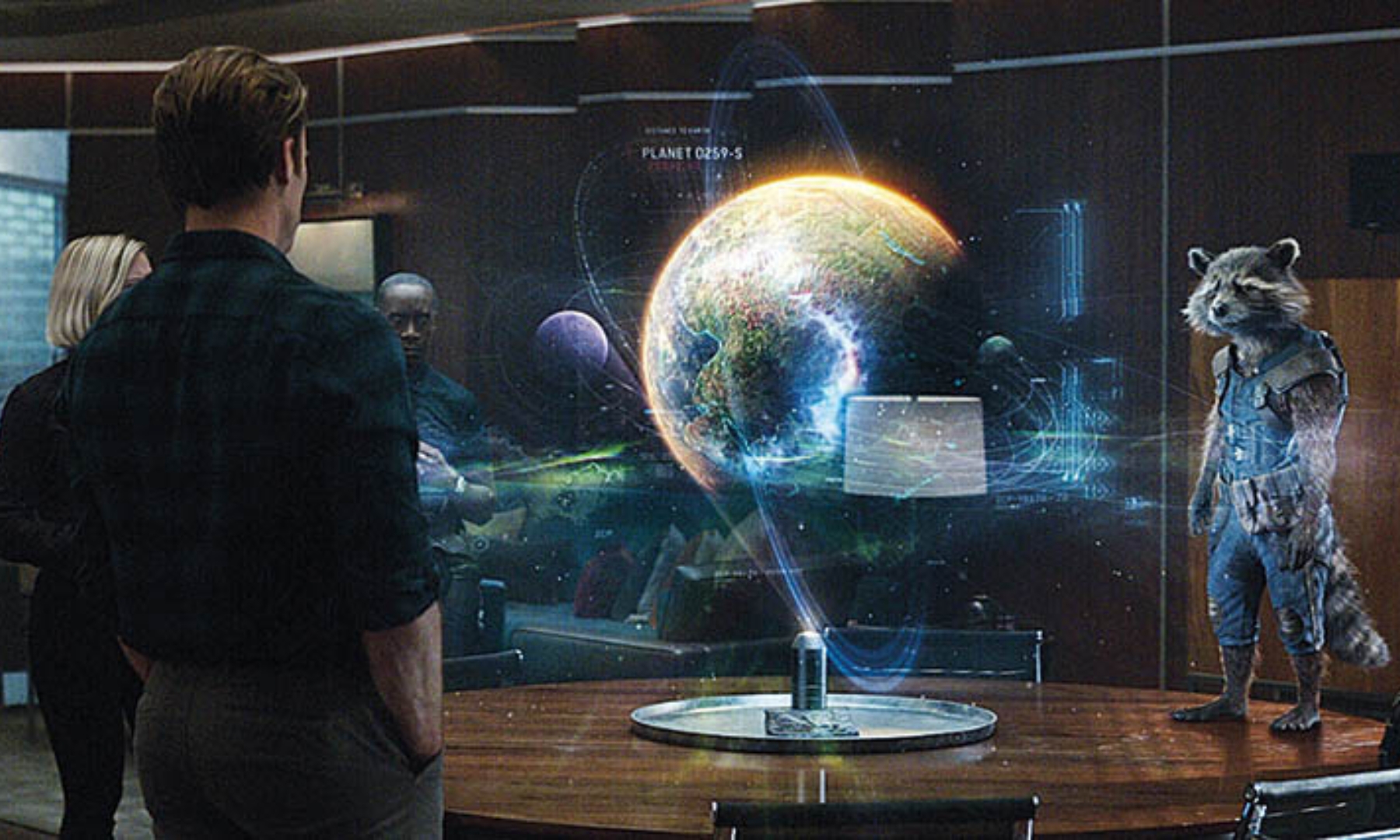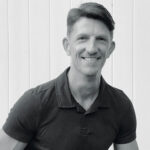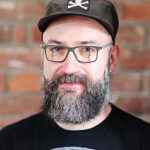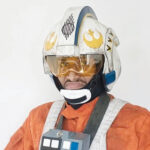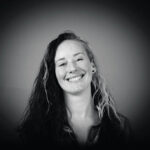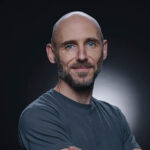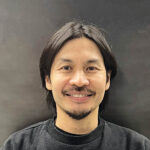Singing Praises For Unsung Heroes
04.15.24Featured in VFX Voice
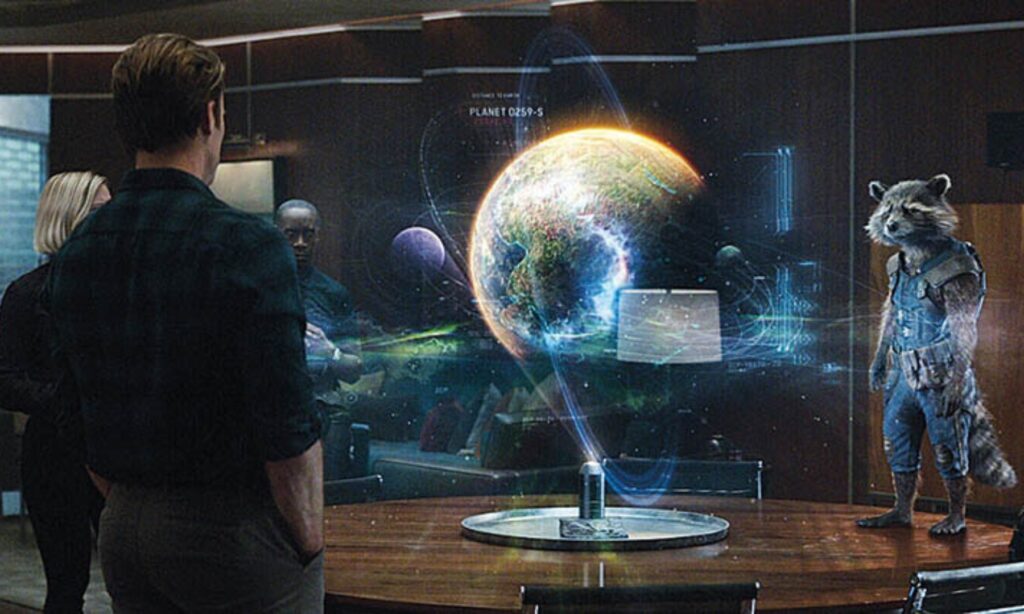
The prevailing question for Aaron Eaton in regard to holograms is how to make something that does not exist look like something that could be captured by a camera, such as this one featured in Avengers: Endgame. (Image courtesy of Cantina Creative and Marvel Studios)
When the final credits roll, it becomes quite clear that you literally need an army of talented individuals spanning a wide variety of professions to make a film or television production a reality. To take a more micro perspective, one can look at the visual effects section where hundreds upon hundreds of names are listed for each of the vendors, and then it truly sinks in – the number of unsung heroes who have contributed their time and talents far from the public spotlight. This lack of awareness also happens within the visual effects industry as generalists have given way to specialists who are more insulated from the contributions of their colleagues in other departments. In an effort to rectify the situation, a number of visual effects companies were asked to put forward candidates deserving of recognition for their exemplary professionalism and skillset. Think of those listed below as just a small sampling of people and occupations that are pivotal in making the visual spectacle and invisible transformation possible.
Aaron Eaton, VFX Supervisor, Cantina Creative
I like that I’m not specialized because I would hate to be doing one single thing all day long! I’m happy to have found Cantina Creative where I can still be a generalist even today. You don’t just work on a shot for an hour, send it off to somebody and never see it again. I’m able to work on something, and it can be very much my own, and you’re involved with it through all of the stages; that has been cool. Compositing is definitely my favorite. It’s that final creative push of bringing something extra to a shot that makes it sit in there and look awesome.
Holograms are a lot trickier than it seems because you’re working on something that doesn’t exist. How do you make the hologram absolutely believable as if it’s something you could film with a camera? There are numerous things that it takes to make the hologram feel integrated into the shot. It has a lot to do with mimicking everything that the camera is doing, with lots of depth in the element, textural elements, noise, grain and glitches. All kinds of subtle features that could come with all of these holograms because a hologram may not be perfection. You have to think about the technology that is projecting or creating the hologram and all of the aspects of how it would actually work.
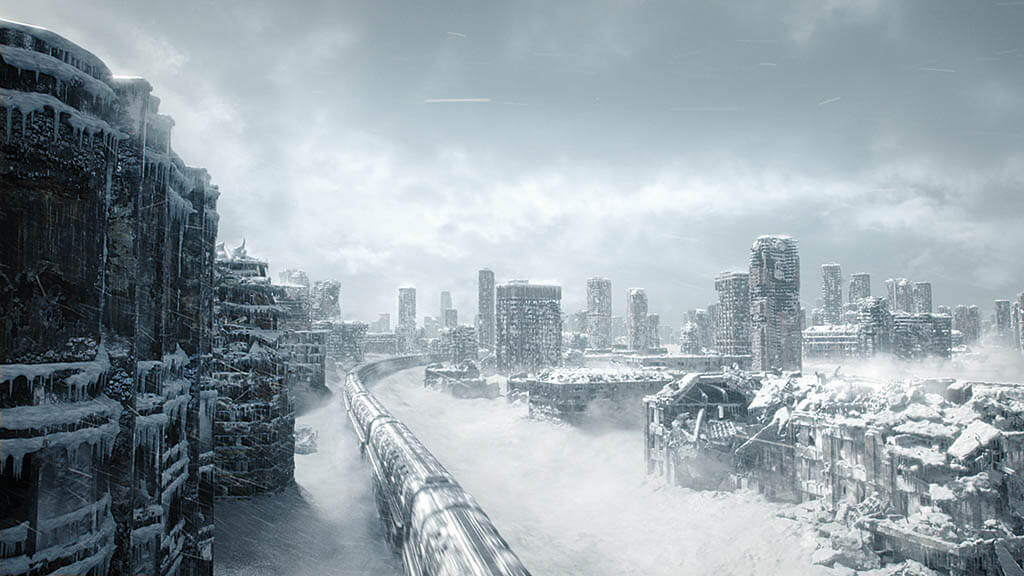
Understanding composition and cinematography was important to Cameron Widen when doing the layout of the exterior train shots for Season 3 of Snowpiercer.
(Image courtesy of Image Engine Design and TNT)
Understanding composition and cinematography was important to Cameron Widen when doing the layout of the exterior train shots for Season 3 of Snowpiercer.
(Image courtesy of Image Engine Design and TNT)
“As workflows and techniques are ever-evolving, for me, it is more important to be on top of the questions that often do not change. How do I stay efficient so that I can be creative? How do I continue to be inspired and to inspire? How do I stay proud of my work?”
—Jason Martin, Layout Artist, ILP
Alan Puah, Head of Systems, Territory Studio
Systems is responsible for some of the most critical parts of the pipeline, things like the storage, network and render farm, which form the backbone of the infrastructure in a visual effects studio. Sometimes the existing infrastructure will dictate how the pipeline works, but often it works the other way around, and we’ll need to upgrade and adapt things to support how a project pipeline is structured.
Creating CGI places some of the highest demands on the technology used, so it’s important to make sure that you’re keeping up with new technology. There is probably more happening now than at any other time as advancements in machine learning and how the exponential growth in computing power impacts our industry. But there’s also been some reversal in trends. For example, in some cases utilizing the cloud hasn’t been the best fit, so there’s been a migration back to on-premise for various reasons that include saving costs or maintaining more control over data and security.
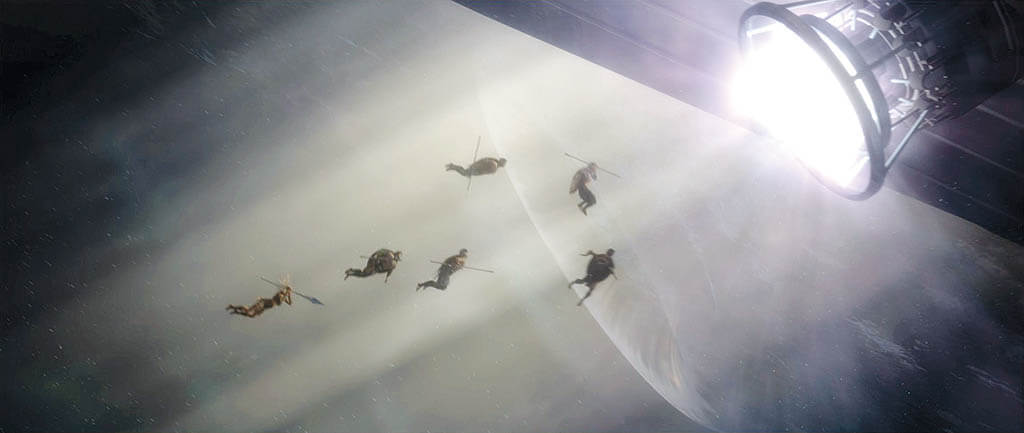
Cameron Ward produced previs for the Black Panther: Wakanda Forever sequence of Namora leading a squad of Taloncail to take out the sonic emitter on the Royal Sea Leopard. (Image courtesy of Digital Domain and Marvel Studios)
Cameron Ward produced previs for the Black Panther: Wakanda Forever sequence of Namora leading a squad of Taloncail to take out the sonic emitter on the Royal Sea Leopard. (Image courtesy of Digital Domain and Marvel Studios)
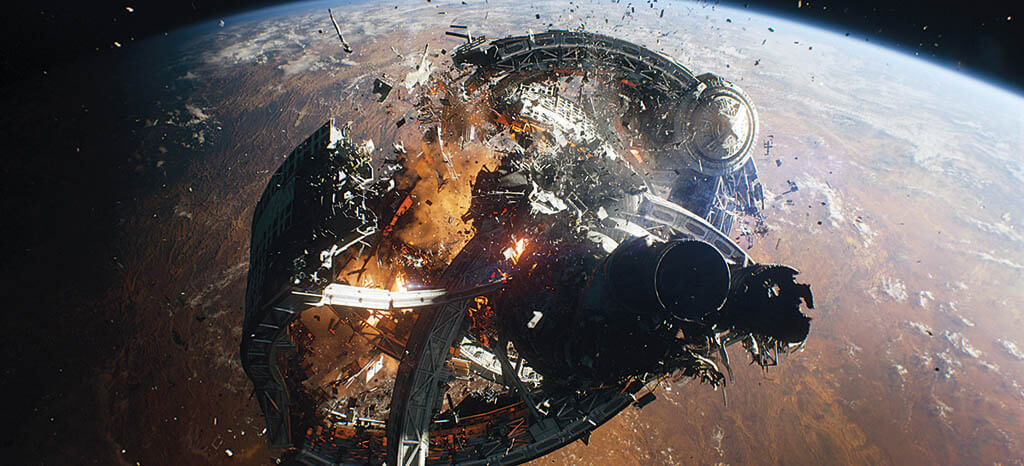
Technical animation had to be created by Jason Martin for Lost in Space Season 2 to support the effects needed for destruction shots. (Image courtesy of ILP and Netflix)
Technical animation had to be created by Jason Martin for Lost in Space Season 2 to support the effects needed for destruction shots. (Image courtesy of ILP and Netflix)

Jeremie Lodomez believes that compositing is vital to seamlessly blend CG, animation and live-action footage, which was the case for the Heroes of the Horn reveal in Season 2 of The Wheel of Time. (Image courtesy of Framestore and Prime Video)
Jeremie Lodomez believes that compositing is vital to seamlessly blend CG, animation and live-action footage, which was the case for the Heroes of the Horn reveal in Season 2 of The Wheel of Time. (Image courtesy of Framestore and Prime Video)

It was the book The Art of The Lord of the Rings that made Jeremy Melton want to be involved with world-building for shows such as The Orville: New Horizons. (Image courtesy of FuseFX and Hulu)
It was the book The Art of The Lord of the Rings that made Jeremy Melton want to be involved with world-building for shows such as The Orville: New Horizons. (Image courtesy of FuseFX and Hulu)
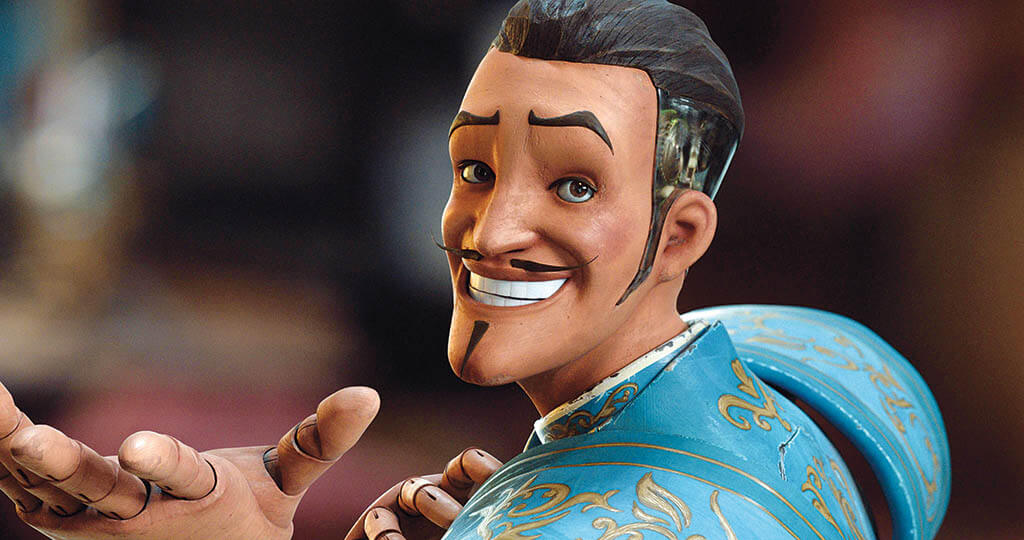
For Maike Fiene, it’s important not to be too precious about visualization, as the needs of a production like Jingle Jangle: A Christmas Journey will evolve over time. (Image courtesy of Framestore and Netflix)
For Maike Fiene, it’s important not to be too precious about visualization, as the needs of a production like Jingle Jangle: A Christmas Journey will evolve over time. (Image courtesy of Framestore and Netflix)
Alicia Carvalho, Senior Rigger, DNEG
I broadly describe my job to people who aren’t in VFX as “putting in the control structures so that animators can animate. “Coming mostly from feature animation, TV and game cinematics, working in a visual effects pipeline has been a really interesting experience, especially when you’re working on rigs where the end result has to match a plate. You have another layer of restrictions of what can move and in what way compared to the relatively free rein you have in Feature when the bounds of what you can do are based on the needs/imagination of an animator.
With machine learning and the move towards game engine integration, it’s going to be more important for artists to hold onto their foundational skills. In general, I’ve noticed a promising trend among companies discussing and wanting to move more female colleagues into supervisory or lead roles, but there doesn’t seem to be enough mentorship support once those positions are filled. There’s definitely always room to improve.
Cameron Ward, Previsualization Artist, Digital Domain
I was on Black Panther: Wakanda Forever, and there were some beautiful renders of the boat as the hydro bombs kept coming and explode beneath it. We had a little time so we could dial it in and make it look great before delivering it to the client, but that’s not always the case. It depends on the project and what the client requires because sometimes they’re only looking for rough. However, sometimes lighting and composition can sell a shot.
Years ago, I was on The Fate of the Furious, and we went to get scans of the city. We were laying out the streets and the heights of the buildings. We got a Dodge Challenger and mounted a camera on its hood. When the day came for shooting, they weren’t paying craft services for four days’ worth of shoots, but for one because they got it all in a day. There’s that aspect as well. You’re cutting down the cost of an actual day of production because you already know your camera angle, focal length, how high you want the camera off the ground and how fast it will be going.
Cameron Widen, Layout, Image Engine
The word ‘layout’ means a different thing for every studio – and often with every person you speak with in a studio. Layout in feature animation is wrapped up a whole lot more in previs-type tasks, like figuring out camera angles and composition. In visual effects, most of the time we’re working with plates that have been shot, so there are not a lot of choices to be made by us in that regard. That said, in almost every project there will be some full CG shots that don’t have associated photography with them, and that’s where we get to flex our creative muscles and use our composition and cinematography skills. Recently, we’ve been getting a push to give our layout versions and presentation that we send for review a much nicer look than what I’m typically used to doing. My preference is to send grayshaded renders for review because then people will be commenting on composition, speed of the camera and camera framing. If our layout versions look too nice and polished then we will start getting visual effects supervisors or other people who will see an issue with a texture map or some shading that we have no control over, and they will fixate on that and won’t make any comment on the layout part.
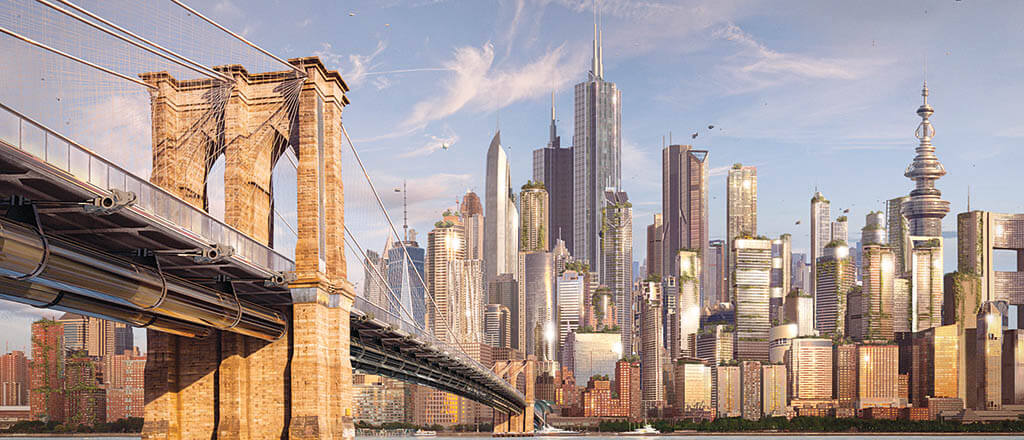
Meliza Fermin created a futuristic Brooklyn Bridge for The Orville. (Image courtesy of FuseFX and Hulu)
Meliza Fermin created a futuristic Brooklyn Bridge for The Orville. (Image courtesy of FuseFX and Hulu)
As a workflow supervisor, Michael Billette spends time informing the various departments at Image Engine how to best utilize the pipeline when working on projects like Bloodshot. (Image courtesy of Image Engine Design and Columbia Pictures/Sony)
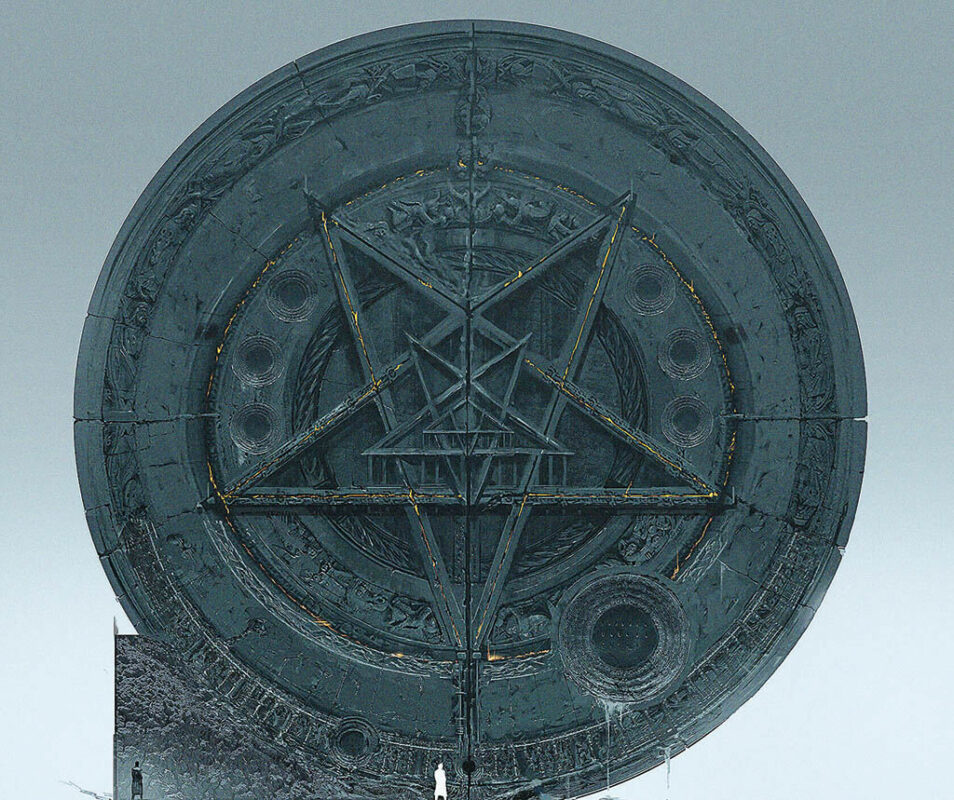
Concept art of Lucifer’s Palace door by Niklas Wallén for the Season 1 of The Sandman. (Image courtesy of ILP and Netflix)
Concept art of Lucifer’s Palace door by Niklas Wallén for the Season 1 of The Sandman. (Image courtesy of ILP and Netflix)
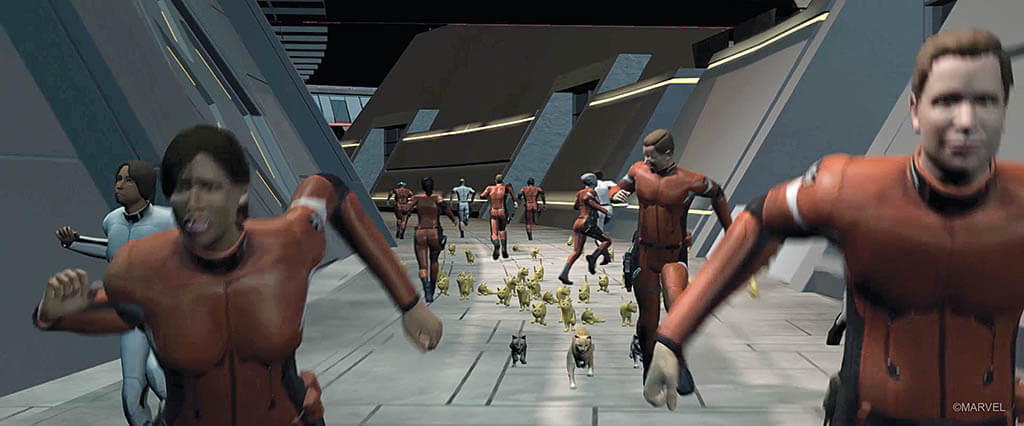
During pre-production and through post on The Marvels, Patrick Haskew provided visualization that was used to help convey a whole crew being swallowed up by Flerkens. (Image courtesy of The Third Floor and Marvel Studios)
During pre-production and through post on The Marvels, Patrick Haskew provided visualization that was used to help convey a whole crew being swallowed up by Flerkens. (Image courtesy of The Third Floor and Marvel Studios)
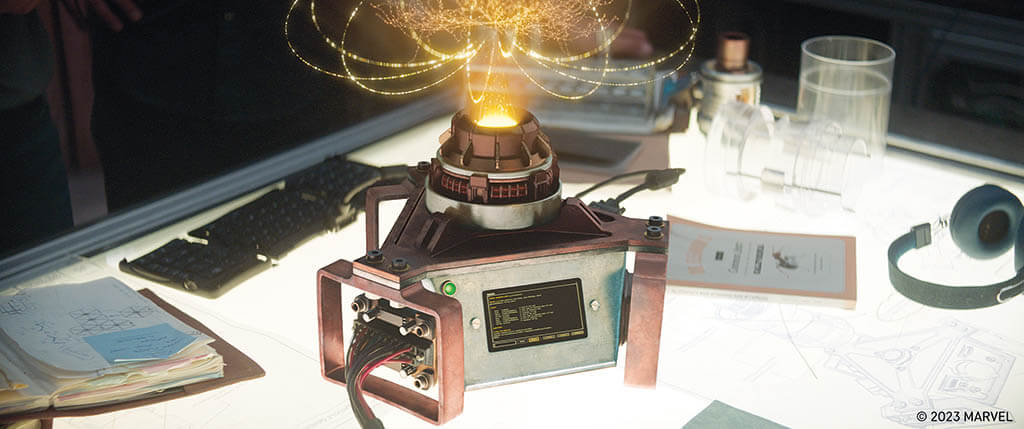
A large part of the job for Sam Keehan is providing the necessary support so that artists can concentrate on their job and produce the best results for clients like Marvel Studios on Ant-Man and the Wasp: Quantumania. (Image courtesy of Territory Studio and Marvel Studios)
A large part of the job for Sam Keehan is providing the necessary support so that artists can concentrate on their job and produce the best results for clients like Marvel Studios on Ant-Man and the Wasp: Quantumania. (Image courtesy of Territory Studio and Marvel Studios)

Turntables are indispensable when submitting textures for review to make sure that the final image has the right reflectivity and surface deformation, such as when working on Shang-Chi and the Legend of the Ten Rings. (Image courtesy of Digital Domain and Marvel Studios)
Turntables are indispensable when submitting textures for review to make sure that the final image has the right reflectivity and surface deformation, such as when working on Shang-Chi and the Legend of the Ten Rings. (Image courtesy of Digital Domain and Marvel Studios)
George Sears, Head of Virtual Production, The Imaginarium Studios
Essentially, my job is to look after all of the real-time technologies on our stage, and that’s everything from basic characters to in-camera effects to LED walls. We also tend to get involved with pre-production looking at assets, the things that we will be driving live and what the director wants to achieve. Then we put together a bunch of real-time technologies that we have at our disposal for that project. I essentially see the job as a tie-in with the animation, mocap and visual effects for films, video games, television, AR and the web. We use Unreal Engine 5 to stream all of our live motion-capture data onto, and that’s where we’ll do the live characters and virtual cameras to support the director. The main reason we do this is that the client can go away on the day, have signed off shots, know exactly what they’re doing and bringing into post-production and, depending on the workflow, sometimes walk away with a real-time edit. They can go into post-production confident that they’ve got everything, and generally it saves a bunch of money and time in the decision-making process. Also, I oversee our pipeline and head a R&D team.
Jason Martin, Layout Artist, ILP
As workflows and techniques are ever-evolving, for me, it is more important to be on top of the questions that often do not change. How do I stay efficient so that I can be creative? How do I continue to be inspired and to inspire? How do I stay proud of my work? [One of the most complex tasks] would be something we call “Technical Animation” that I did on Lost in Space S1 and S2 to support effects on the destruction task where large environments or spacecrafts collapse or get destroyed. I would supply a semi-detailed version of the event to effect, made with various methods in Maya, like keyframe animation, rigid simulation, cloth simulation or deformation, that talented effects artists would enhance, develop or add to. This workflow enabled us to maintain a high level of artistic control on small-sized teams often consisting of me plus one to two persons, but the sheer amount made it complex.
Jeremie Lodomez, Global Head of 2D – Film & Episodic, Framestore
Compositing plays a vital role in the visual effects pipeline, seamlessly blending elements such as CG, animations and live-action footage in the final output. It enhances realism and supports storytelling by ensuring all elements are consistent in lighting, perspective, and color. My aspiration is for compositors to perform rapid iterations within their software. For instance, tweaking a CG environment without getting entangled in lengthy interdepartmental revisions. This approach would enable swift creative iterations, with the potential to integrate these fixes into later stages of the pipeline. The rise of technologies like USD and Unreal Engine heralds a future where compositors could emerge as more dynamic players in the field, evolving into Image Composition Artists. The fact that audiences are unable to discern our visual effects work speaks volumes about the quality and realism we achieve.
Jeremy Melton, Art Department Supervisor/DMP/ Concept Artist, FuseFX
I saw The Art of The Lord of the Rings when it came out, and my mind was blown. I said, ‘That’s what I want to do.’ As an art director supervisor, I try to encourage everyone to be an artist, be the best that they can, and encourage them to go in the direction that they want to go. Not pigeonhole someone or make them do something that they don’t want to do. But at the same time there is the corporate side of making sure that the budgets and all of the rules are being followed, that we’re doing everything that we’re supposed to do. It’s wild. I was never trained in it. I worked into the position by experience. You have to be open, especially with the advent of AI using Blender or ZBrush, whatever helps the artist to get to where they need to be to create the best possible image. That’s one thing I want to encourage. Instead of, ‘This is how it’s done,’ let’s open it up.
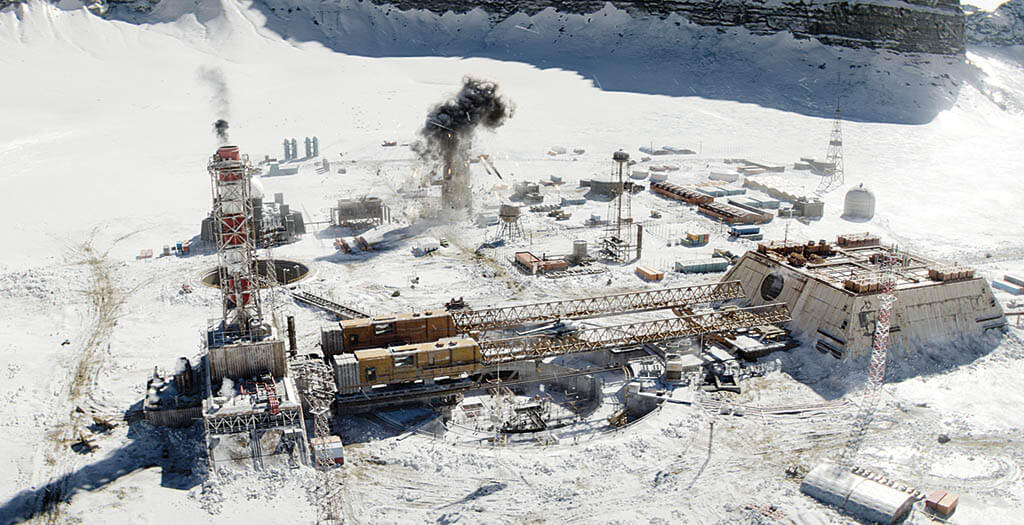
Thomas Mouraille believes that the term ‘Environment/Generalist’ is better than ‘Matte Painter’ as it more accurately describes the work done for shots of the gulag
in Black Widow. (Image courtesy of Wētā FX and Marvel Studios)
Thomas Mouraille believes that the term ‘Environment/Generalist’ is better than ‘Matte Painter’ as it more accurately describes the work done for shots of the gulag
in Black Widow. (Image courtesy of Wētā FX and Marvel Studios)
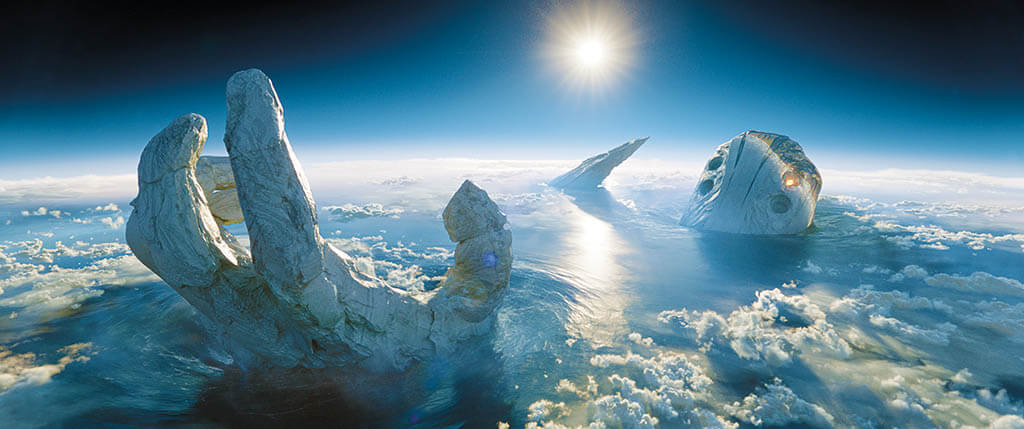
Thomas Mouraille makes use of 3D software, such as Maya, ZBrush and Substance combined with 2D elements created in Photoshop, to produce matte paintings for The Eternals. (Image courtesy of Wētā FX and Marvel Studios)
Thomas Mouraille makes use of 3D software, such as Maya, ZBrush and Substance combined with 2D elements created in Photoshop, to produce matte paintings for The Eternals. (Image courtesy of Wētā FX and Marvel Studios)
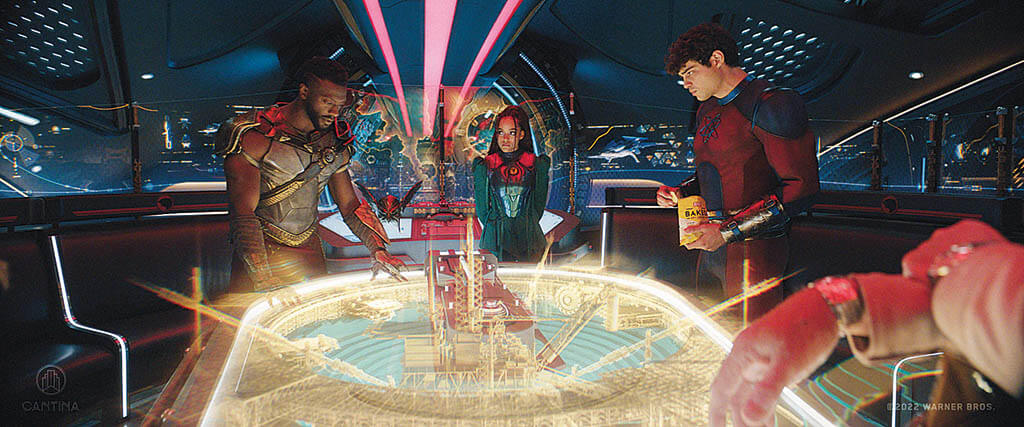
When creating technology for the big screen, one has to keep in mind how it would actually work, which was the case for Aaron Eaton when working on Black Adam.
(Image courtesy of Cantina Creative and Warner Bros. Pictures)
When creating technology for the big screen, one has to keep in mind how it would actually work, which was the case for Aaron Eaton when working on Black Adam.
(Image courtesy of Cantina Creative and Warner Bros. Pictures)
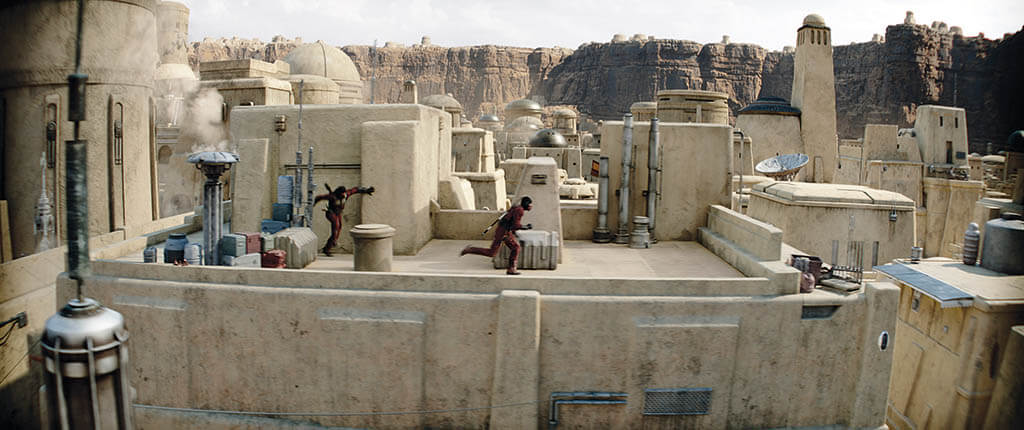
When working with plate photography. Cameron Widen has a lot less creative freedom for layout than when dealing with full CG shots, as reflected in The Book of Boba Fett. (Image courtesy of Image Engine Design and Lucasfilm Ltd.)
When working with plate photography. Cameron Widen has a lot less creative freedom for layout than when dealing with full CG shots, as reflected in The Book of Boba Fett. (Image courtesy of Image Engine Design and Lucasfilm Ltd.)
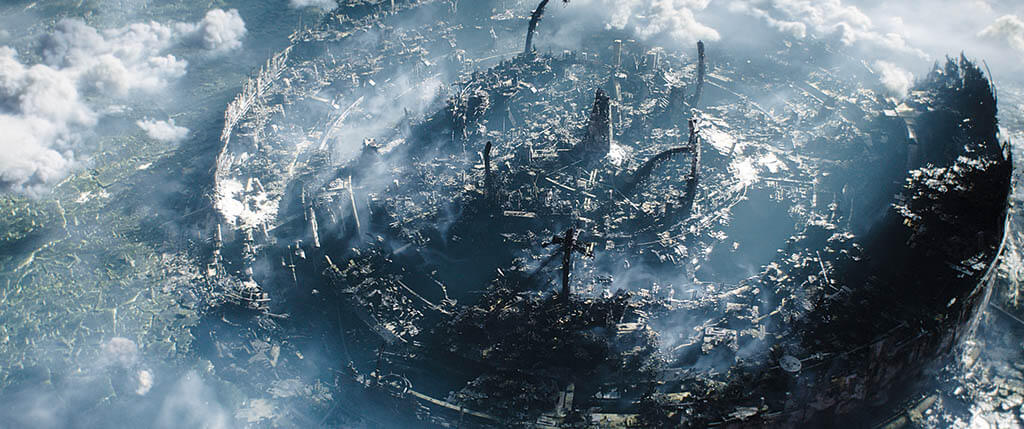
There are constant questions that Jason Martin is always trying to answer, such as how to stay efficient in order to be creative when working on an image of Sundari in Season 3 of The Mandalorian.
(Image courtesy of ILP and Lucasfilm Ltd.)
There are constant questions that Jason Martin is always trying to answer, such as how to stay efficient in order to be creative when working on an image of Sundari in Season 3 of The Mandalorian.
(Image courtesy of ILP and Lucasfilm Ltd.)

Being an art department supervisor means that Jeremey Melton also has to be conscious of budgetary restrictions when working on The Orville: New Horizons.
(Image courtesy of FuseFX and Hulu)
Being an art department supervisor means that Jeremey Melton also has to be conscious of budgetary restrictions when working on The Orville: New Horizons.
(Image courtesy of FuseFX and Hulu)
Katie Corr, Lead Facial Animator and Facial Capture Technical Director, The Imaginarium Studios
It’s quite fun working with a lot of different clients because you’ve got some realistic projects that use metahumans, and that’s one of our pipelines. Then you have stylized projects that are cartoony, and I get to have a bit more freedom with that. My job begins from onstage with capture, and that means taking care of the actors, making sure that the client is happy, and capturing the date so that the post team can make sure that they get a good result on their tracking. Then, we move on and start tracking through one of our pipelines. From there we take it onto their provided rig and do final cleanup to their specs that they have been asked for depending on the game, movie, TV show or ad. Anything you can think of, we’ve attempted! The more time you spend on it, the higher quality it becomes. It’s quite a subjective area. You try to nail down little nuances like nose flares or when someone is breathing or little eye twitches. The fun part of the job is you get to hear the request from the client, then challenge yourself, find ways around it and maintain their expectations.
Maike Fiene, Visualization Supervisor, Framestore
Visualization being the first step to showing the interaction with the CG elements, it is essential to accept that there will be changes to the work as it develops, and you need to be able to adapt and cannot be too precious about it. It is also rewarding as you get to shape the interaction of fun and sweet character moments. This is a very fast-paced environment and requires a general skillset of: understanding of practical filming techniques; being able to interpret storyboards and scripts; general overview and intention of the sequence you are working on (tone, timing, what purpose does this sequence have in the film? What is the director trying to communicate?); general understanding of cinematography (staging, lighting, composition); and all-round technical troubleshooting skills.
In postvis, we’re often collaborating with the finals teams as they might have developed assets further or are developing character animations, and we try to incorporate as much of that as possible to stay true to the final look of the project. This gives the director a chance to shape his vision of the edits at an early stage and test out ideas, and it gives the finals teams a solid foundation to start from.
Meliza Fermin, Lead Digital Matte Painter and Sr. Compositor
As a matte painter, you’re in the beginning of the process, and I prefer that because you have more time, it’s a lot more creative, and you’re choosing more of the elements that are going to be used. Our clients say, ‘I want New York in the 1960s.’ You have to create that, but I’m the one who chooses all of the photographic elements to put together so it works in that environment. You have some creative input. Some studios have me do the matte painting and comp it, or I have worked where I was strictly a matte painter and hand it off to the compositor. The nice thing about having both is I know the problems compositors are going to run into; I have already prepped the matte painting so it does work, and they don’t have to come back to me. Compositing is more technical than creative. Sometimes there’s no time to go back to CG or matte painting, so you have to find fast ways to fix it. You’re a problem-solver.
Michael Billette, Workflow Supervisor, Image Engine Design, Inc.
We’re constantly talking to every department about the challenges of their day-to-day job, and we think about how things can be improved and how can they utilize the parts of the pipeline we have already developed they might not be aware of or understand how it could be applied. We do a lot of trying to teach people how to use the tools. Then we also think about how can we improve upon our processes and keep things in sync. We can only do so much as a support department, and it’s not necessarily fast enough for what people need on the floor. Often times, if artists are developing their own workflows or tools, things get very fragmented very fast. Each person tries to do their own solution and can go down different roads. We try to keep things in line because it’s a lot easier for the technical teams to develop when they don’t have all of these parallel processes to work on. They can create some core features and make sure they can support the other workflows that are needed.
Niklas Wallén, Concept Artist, ILP
You need to have your fundamentals as a concept artist and some design rules that you can always apply that will make it look better. But sometimes I get given things and go, ‘I don’t see the problem here.’ When I began at ILP, my mentor, Martin Bergquist, told me, ‘Your job is to check out the art direction and documents from the client and what they had in mind from the start, be good with that and create a design rule book. But then you take those design rules and have fun with them.’ If you have these design rules in yourself always, it’s easy to spot when something is wrong with an image. Whether it’s The Mandalorian or The Sandman that have totally different shape languages, I can tell quickly if this is out of line because there’s usually someone who has built the stuff, has been with it for a long while, and maybe they have put themselves into a rabbit hole and forgotten what the shape language is. It’s my job to go in and say, ‘That will work better if I did this.’
Patrick Haskew, Sr. Visualization Supervisor, The Third Floor
Visualization helps build the foundation of what you see on the silver screen. Because you can iterate quickly and work closely with many collaborators – including the VFX Supervisor – from day one on the production, the process is invaluable in helping develop the look of the visuals as it relates to telling a believable [shootable] story. We are also able to provide and use technical visualization and virtual production tools that help connect what’s visualized to shots and equipment on set, and ensure that work and plans from pre-production carry through and can be built upon through post.
The industry is always trying to figure out how to make film and television cheaper and faster, and we are at the forefront of that endeavor. But, at the end of the day, the relationships built with the directors, producers and VFX supervisors are at the heart of the process. Technology will always change, but it all starts from an idea to tell a story audiences will love. We are in that room and help represent that storytelling vision.
Patrick Smith, Head of Visualization, MPC
Visualization has grown out of its infancy and is starting to get into its teenage punk-rock years. With the advent of all the tools and real-time technology that is coming to the forefront with virtual production, visualization is certainly a key component of that evolving filmmaking pipeline, and it shines a spotlight on everything that we’re doing. It’s taken off like wildfire. Everybody and their brother have a visualization studio now, and every visual effects house is folding a visualization department into the front-end of their pipeline. The easiest way of understanding visualization is likening it to sculpture. Imagine starting with a giant slab of marble and saying, ‘We’re going to sculpt the Statue of David.’ And everybody is wondering, ‘What does that look like?’ What you’re doing is helping to develop and shape what the visual aesthetic of that actually looks like. You can consider previs to be your rough draft, go and shoot, and then finalizing what that draft is so you are setting up your finals team for success on the back-end of that.
Sam Keehan, Creative Director, Territory Studio
The most important thing about being a creative director has always been to try as often as I can – whether that be when we’re resourcing projects or hiring people – to surround myself with people who are better than me. There will be particular skills that people will be way better at than me. We can talk, and they can go and enjoy the thing that they’re really good at and come up with interesting stuff. I will be able to sit back and say, ‘Yes. That’s exactly what I was thinking.’ The inherent difficulty is if you’ve got multiple people across multiple jobs. You want to make sure that everyone is getting the best work out, but the only people getting the best work out are the ones getting enough support. For my job, in particular, it feels like a lot of it is facilitation and making sure that people have the support they need to just concentrate on the job that has to get finished.
Stuart Ansley, Lead Texture Artist, Digital Domain
The way I describe being a texture painter is to imagine if you went to a toy model shop, got a figurine or car and have to paint colors and details onto them. Sometimes there is metallic stuff or shiny things and you have to decide what color something is going to be, how reflective it is going to be and how dirty it is going to be. We put in all of those little details. In order to be good at the job, you have to have an eye for color, composition and detail. You have to see the little things. I get into trouble when sometimes I have conversations with people and I zone out and my eyes glaze over. It’s because I’m looking at their forehead pores or the way their eyes wrinkle. My wife will always call me out! Whenever submitting our work for review, we always view it in a turntable so the object itself is turning and the lights are turning around it as well, because it’s so important the way the light scrapes across the surface so that you’re getting the right reflectivity and surface deformation.
Thomas Mouraille, Lead Matte Painter, Wētā FX
In a nutshell, we could group the software we use in three categories. We use the first group for creating 3D assets, the second for assembling scenes and the third for creating and adjusting 2D content. We create 3D elements using software such as Maya, ZBrush, Substance and Mari, as well as Houdini and Gaea for terrain. The scene assembly process is done within Clarisse iFX and Houdini. The 2D elements are created and adjusted using Photoshop and Nuke. When required, we use specific software such as Terragen, Reality Capture or Unreal Engine for bespoke tasks.
The matte painting step represents around 10% to 20% of the entire work we actually produce on a show. The bulk of the work is now done using 3D packages. “Environment/Generalist” would be a more correct name to define what we do. The tools evolve quickly, and the current AI breakthrough will likely bring new tools to our toolbox soon. It is already happening with software like Photoshop and Nuke, which have some AI-driven tools. The real-time engines are also being incorporated into the visual effects industry as a solution to render final pixel. It is something we keep a close eye on, and are slowly integrating in our pipeline.
Aaron Eaton
Alicia Carvalho
Cameron Ward
Cameron Widen
George Sears
Jason Martin
Jeremie Lodomez
Jeremy Melton
Katie Corr
Maike Fiene
Meliza Fermin
Michael Billette
Niklas Wallén
Patrick Haskew
Sam Keehan
Stuart Ansley
Thomas Mouraille
Alan Puah
Patrick Smith


